Sir Gregory P. Winter
Biographical
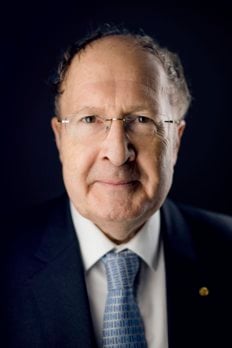 Summary
Summary
I was born (14 April 1951) in Leicester, England but spent most of my childhood in the Gold Coast (later Ghana). The family returned to England in 1964, settling in Newcastle-upon-Tyne. There I went to the Royal Grammar School, which developed my interests in chemistry and biology and set me on a path to Cambridge University (Trinity College), a BA in Natural Sciences (1970–1973) and PhD in protein chemistry (1973–1976).
Most of my research career (1973–2012) was based at the Medical Research Council’s (MRC) Laboratory of Molecular Biology (LMB), Cambridge. I undertook my PhD and postdoctoral work at the LMB. I was appointed to the MRC’s scientific staff at the LMB in 1981, and became Head of the Division of Protein and Nucleic Acid Chemistry (1994–2008) and Deputy Director of the LMB (2006–2011). I was also Deputy Director of the MRC Centre for Protein Engineering (1990–2010), and held Fellowships at Trinity College, Cambridge (1976–1980; 1990–2012; 2019–). I was appointed Master of Trinity from 2012–2019.
My research developed from my interests in the chemistry and structure of proteins and nucleic acids. After a period (1973–1982) sequencing proteins and nucleic acids, I developed genetic engineering as a tool to analyse protein functions, applying it to a study of the binding and catalytic mechanism of an enzyme (1982–1988). I also developed genetic engineering strategies for the design (1984–1988) and evolution (1988– 1997) of antibody pharmaceuticals suitable for treatment of cancer and immune disorders, helping to spearhead the development of antibodies as a new class of powerful biologics. Subsequently I have contributed to the development of bicyclic peptides and their conjugates as medicines. In the course of my academic research, I have worked with industry as a consultant, and also as a founder and director of two start-up companies based on antibodies, Cambridge Antibody Technology Ltd (founded in 1989, listed on the London Stock Exchange in 1997, sold to AstraZeneca in 2006), Domantis Ltd (founded in 2000, sold to GlaxoSmithKlein in 2007), and one start-up company based on peptides, Bicycle Therapeutics Ltd (founded in 2009) and listed on Nasdaq in 2019.
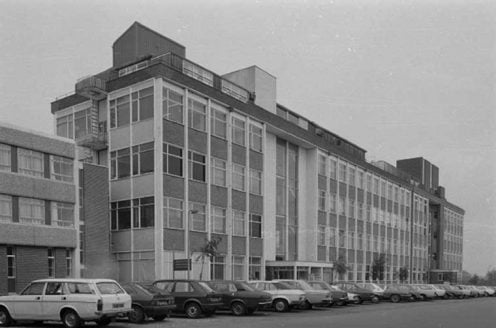
Figure 1. MRC Laboratory of Molecular Biology, 1970.
Credit: MRC Laboratory of Molecular Biology.
Credit: MRC Laboratory of Molecular Biology.
Enzymes
I started my PhD studies at the MRC Laboratory of Molecular Biology, Cambridge (LMB) in the autumn of 1973, funded by an MRC studentship and supervised by Brian Hartley, a protein chemist. With LMB colleagues David Blow (protein crystallographer) and Alan Fersht (enzyme kineticist), Brian aimed to compare the amino acid sequences, crystallographic structures and catalytic mechanisms of an ancient family of enzymes, the aminoacyl tRNA synthetases, and to gain insights into the early evolution of proteins. For my PhD, I was supposed to determine and compare the sequences of the tryptophanyl (TrpTS) and tyrosyl tRNA (TyrTS) synthetases by protein chemical methods, in the hope of identifying a sequence motif involved in catalysis. During my PhD studies, Brian was appointed to the Professorship of Biochemistry at Imperial College, and I had to follow him to London in the autumn of 1975 and help set up the protein chemical facilities. Nevertheless, I managed to complete the sequence of the TrpTS by the summer of 1976, the work forming the core of my Cambridge PhD thesis and a successful application for a Junior Research Fellowship at Trinity College.
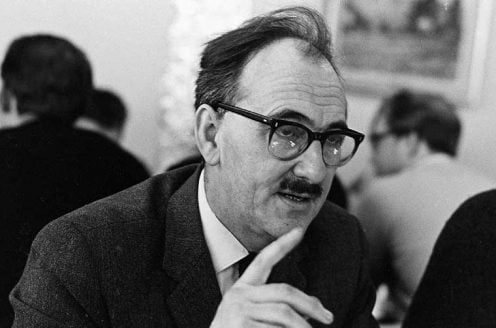
Figure 2. Brian Hartley in 1969.
© Jens Birktoft/MRC Laboratory of Molecular Biology.
© Jens Birktoft/MRC Laboratory of Molecular Biology.
In the meantime, David Blow had obtained good crystals of the TyrTS and needed the amino acid sequence to solve its three-dimensional structure. I postponed my return to Cambridge for over a year, trying to complete the sequence, but without success. Nevertheless, I was able to provide large segments of TyrTS sequence to David and to compare it with the TrpTS sequence. This revealed a cysteine (Cys 35) in the N-terminal region of both enzymes, a region identified by David as part of the tyrosyl adenylate binding site and hinting that Cys35 might have a role in catalysis.
After hearing a lecture from Fred Sanger on his new DNA sequencing methods, I concluded it would be easier to deduce the amino acid sequence of a protein from the DNA sequence of the corresponding gene than by direct chemical sequencing of the protein. Accordingly, I decided to learn DNA sequencing, and taking advantage of the salary provided by my Trinity Fellowship, applied to join Fred back at the LMB. In turn he passed on my application to his colleague George Brownlee.
George was planning to sequence the genome of influenza virus to help understand the mechanisms underlying influenza virus epidemics and pandemics. He had also taken on a PhD student, Stanley (Stan) Fields. We first had to grow the virus in eggs, isolate the viral RNA and then make cDNA copies. Instead of cloning each of the individual genome segments, we used an M13 shotgun strategy to sequence all the segments together, working closely with Fred’s group. During this work George was appointed to the Professorship of Chemical Pathology in Oxford, but Stan and I were allowed to stay at the LMB to complete the sequence. By 1981, we had completed the sequence, and Stan left for a postdoctoral position in the USA.
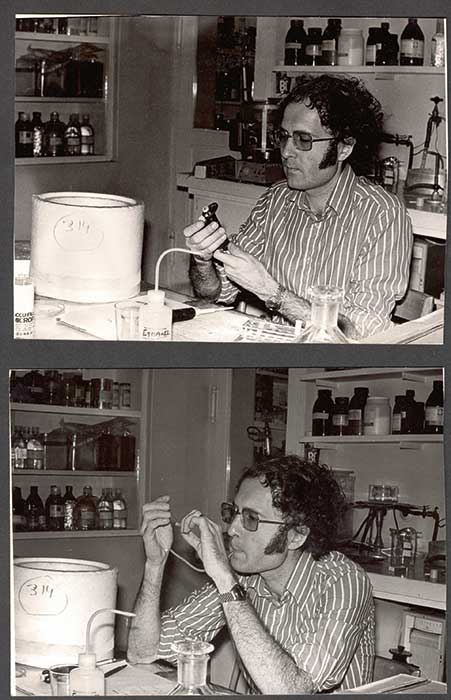
Figure 3. Gregory Winter in c.1980 demonstrating two methods for pipetting small volumes.
Credit: MRC Laboratory of Molecular Biology.
Credit: MRC Laboratory of Molecular Biology.
Although the sequence of the influenza genome was now available as a framework for further understanding of the epidemiology and biology of the virus, I couldn’t shake off a longing to return to a world of proteins, structure and mechanism. Now thoroughly familiar with recombinant DNA technology, I saw huge potential in the application of this technology to the structure-function studies of proteins. Although my Trinity salary expired in the autumn of 1981, Fred Sanger offered me a short-term MRC position to explore these ideas.
Fortunately, an opportunity soon materialised: a former colleague at Imperial College, David Barker, had cloned the gene for TyrTS, and joined me for a couple of months in Cambridge to learn DNA sequencing and to help sequence the gene. The gene was soon sequenced, and David Blow (now at Imperial College) provided with the sequence information necessary to complete his model of the three-dimensional structure of TyrTS. David Barker also sequenced the methionyl tRNA synthetase (MetTS), revealing a constellation of residues (Cys35…His 45… His 48) conserved with the TyrTS, again implicating Cys35 in the catalytic mechanism.
To obtain experimental evidence for the role of Cys35, I decided to mutate the Cys35 to a serine residue in the cloned TyrTS gene, and to express and characterise the mutant enzyme. For this purpose, I used oligonucleotide-directed mutagenesis, travelling to Michael Smith’s laboratory in Vancouver for six weeks to learn the latest methods from his postdoctoral worker Mark Zoller.
On my return from Canada, I collaborated with Alan Fersht (now at Imperial College) to understand the effects of this and other mutations on the enzyme mechanism. We confirmed that Cys35 was a key catalytic residue, but also found that the Ser35 enzyme was weakly active. In due course, by exploring other mutations around the active site, we established that the catalytic mechanism of the enzyme involved the preferential stabilisation of the tyrosyl adenylate transition state by multiple non-covalent bonds (including bonds from a mobile loop involving His 45).
As we improved our methods for site directed mutagenesis and synthesis of oligonucleotides, we started to undertake larger scale mapping projects. In particular we mapped the path of the tRNA across the enzyme, and later, by the same approach, mapped the binding site for complement C1q in antibodies. With site-directed mutagenesis established as a powerful analytical tool for studies of protein structure and function, I started on the next phase of my career.
Antibodies
In October 1983 Fred Sanger retired and César Milstein took over as Head of Division. César’s passion was antibodies – particularly the mechanisms underpinning their diversity. He agreed to my tenure but suggested that I use site directed mutagenesis to study the structure and function of antibodies. In January 1984, I was attacked on the way to work, and my shoulder dislocated, leaving my right arm temporarily paralysed. No longer able to work at the bench, and as a distraction from the pain caused by the nerve damage, I immersed myself into a virtual world of protein structures using the LMB’s Evans and Sutherland PS300 computer graphics system. I was particularly interested in the architecture of binding sites. In the light of César Milstein’s suggestion, I started to look carefully at antibodies.
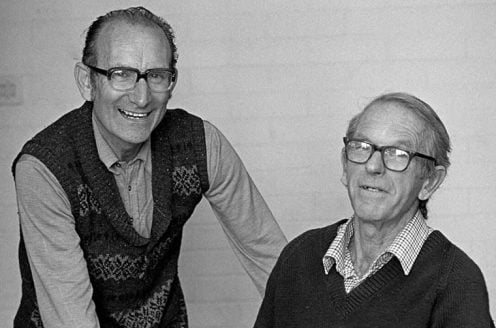
Figure 4. Cesar Milstein and Fred Sanger, mid-1980s.
Credit: MRC Laboratory of Molecular Biology.
Credit: MRC Laboratory of Molecular Biology.
At that time, only the three-dimensional structures of human and mouse myeloma proteins were known. Human myeloma proteins are a species of antibody produced in myeloma patients and for which we do not know the cognate antigen. Nevertheless, it was supposed that the antigen binding sites were located in regions of hypervariable sequence in the loops of the variable (V) domains; indeed Elvin Kabat had called the hypervariable regions “complementarity determining regions” (CDRs), and the regions outside the CDRs he called Framework Regions (FRs).
Inspection of the antibody architecture suggested to me that if Kabat was right, the antigen-binding activity of one antibody might be transferred to another by CDR transplant. This offered the prospect of endowing human myeloma proteins with the binding activities of rodent monoclonal antibodies, and so creating “humanised” [see Note 1] antibodies with predetermined binding activities for treatment of human disease, particularly non-infectious diseases such as cancer. I was aware that rodent monoclonal antibodies were seen as “foreign” in patients, provoking a blocking immune response, and anticipated that “humanised” antibodies (up to 95% human), might provoke a lesser response.
Accordingly, I designed a synthetic gene encoding an antibody variable domain in which the CDRs from a mouse monoclonal antibody with known binding activity were stitched into the framework regions of a human myeloma protein. César Milstein allocated a post for a research officer, and was joined by Peter Jones, who acted as my right hand man until my retirement. We set about creating the gene by the chemical synthesis and assembly of oligonucleotides and produced the humanised antibody in myeloma cells using expression vectors kindly provided by Michael Neuberger (LMB). This took us some 18 months of work, and to our relief we found that the humanised antibody bound to the same target as the original mouse antibody, and with similar binding affinity.
We followed up with two more humanised antibodies; in these cases, we had to engineer mutations into the packing contacts between FR and CDR residues to fully restore binding affinities. One of these antibodies, a rat monoclonal antibody against a lymphocyte marker, was humanised in collaboration with Herman Waldmann’s group (Cambridge Department of Pathology). This antibody had been chosen for its therapeutic potential and within months, the humanised antibody was used to destroy a large tumour mass from the spleens of two patients with non-Hodgkins lymphoma.
On the advice of César Milstein, I had filed a patent on the humanising technology, but then found myself embroiled in discussions with my employers, the MRC, in formulating the best licensing strategy. Fortunately, the MRC finally agreed to adopt a largely non-exclusive licensing policy, similar to that used for the licensing of the Cohen Boyer patents on recombinant DNA technology, with a small upfront payment and a low royalty. Later the MRC’s Collaborative Centre for Industry at Mill Hill offered a service to industry for humanising antibodies. These strategies encouraged the uptake of the humanising technology by companies, and led to the development of several therapeutic antibodies, marketed mainly for treatment of non-infectious diseases such as cancer and immune inflammatory disorders.
In the course of our work in humanising mouse hybridomas, we developed a set of PCR primers to amplify and clone the genes encoding the antibody variable domains from hybridomas. As explained in more detail in the Nobel Lecture, this technical advance also opened up the prospect of making human antibodies from V-genes harvested from human lymphocyte populations. However, we soon became aware of competition: the Scripps Research Institute and the biotechnology company Stratagene appeared to be working together along similar lines. We had yet to develop a screening method of sufficient power and realised that with our limited resources we would be outgunned.
Companies
At that time the MRC was unable to offer more resources, and so I sought external collaborations with industry. We had filed patent applications on our work, but industry saw the ideas as too “blue sky”. I therefore mused about starting my own biotechnology company and using it as a vehicle to develop the screening methodology. After a lecture at Amersham International in the summer of 1989, one of the Amersham employees, David Chiswell, offered to help me set up such a company. Around this time, I also had a visit from an Australian friend, Dr Geoffrey Grigg, who had already founded his own company (Peptech) in Sydney. He loved the “blue sky” ideas, and offered to help with funding, but we first had to bring together all the various interested parties. After two months we had a deal: the MRC agreed to license the patents to a new company, Cambridge Antibody Technology (CAT), in return for an equity stake and a product royalty; Peptech agreed to provide CAT with a draw-down loan convertible to equity; David Chiswell agreed to become the Managing Director of the company and set up the laboratory facilities; and I agreed to split my time between my academic studies and the company for several years. The deal also included the provision that CAT would fund an employee to work in my group at the LMB to explore strategies for mass screening of antibodies, including the use of filamentous bacteriophage.
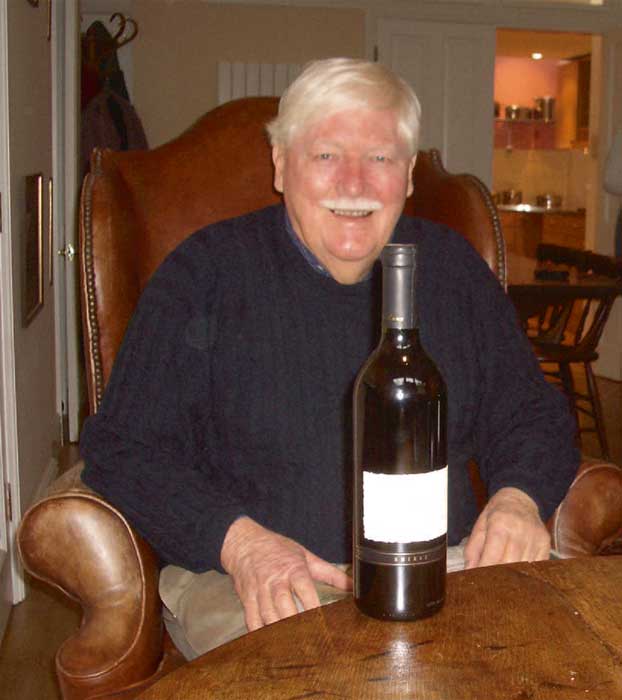
Figure 5. Geoffrey Grigg (photo from 2004).
Credit: Gregory Winter.
Credit: Gregory Winter.
In early 1990 John McCafferty (formerly Amersham and now a CAT employee) joined my group. He soon discovered that antibody fragments could be displayed on filamentous bacteriophage and that binders could be enriched by factors of one thousand-fold in each round of affinity selection. More good news followed – in the autumn of the same year the MRC offered me further space and posts in a refurbished building adjacent to the LMB. This was the MRC’s new Centre for Protein Engineering (CPE), a species of research institute originating from a government initiative to encourage academic and industry collaborations. Alan Fersht (now back in Cambridge at the Chemistry Department of Cambridge University) was appointed as Director of the CPE, and I became the Deputy Director.
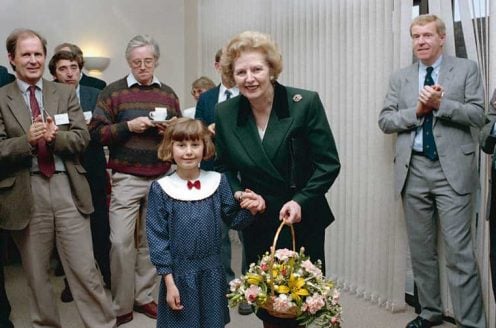
Figure 6. Caroline Winter (GW daughter) and Margaret Thatcher at the opening of the MRC Centre for Protein Engineering in 1991.
Credit: MRC Laboratory of Molecular Biology.
Credit: MRC Laboratory of Molecular Biology.
The antibody work flourished in the CPE, and the explicit link with industry facilitated our collaborations with CAT. We isolated “binders” from human phage antibody libraries, explored methods for mutating and selecting antibodies with improved affinities, and showed that high affinity human antibodies could be isolated directly from very large libraries. The CPE became a hub of antibody expertise, with projects to develop new antibody formats (including diabodies and later single domains), and to clone all the human germline antibody segments which we used as building blocks for synthetic human antibodies. Most importantly we isolated human antibody fragments against human self-antigens from the antibody libraries.
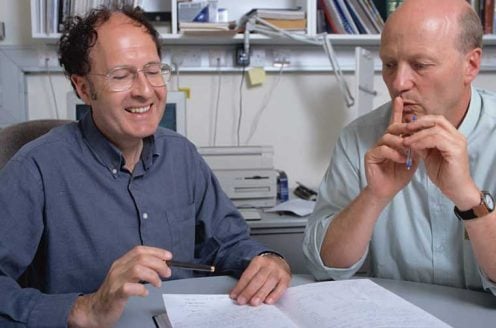
Figure 7. Gregory Winter with Peter Jones early 1990s in the Centre for Protein Engineering.
Credit: MRC Laboratory of Molecular Biology
Credit: MRC Laboratory of Molecular Biology
In CAT the scope for rapid expansion was more limited due to the limited cash reserves and the difficulties of finding further investors. Fortunately, a collaborative contract with Knoll Pharmaceuticals (later acquired by Abbott Laboratories) was successful and led to the development of the antibody adalimumab (Humira) against the inflammatory mediator TNFalpha. This later became the first human therapeutic antibody to be approved for marketing by the US Food and Drug Administration (2002) and the world’s top selling pharmaceutical drug. By 1996 the company had started to prepare for an initial public offering (IPO) on the London Stock Exchange and was floated in 1997. However, the preparations for the IPO brought out tensions between investors and split the Board. As most of the antibody technology was by now well established, I stepped down from the Board and left CAT before the IPO.
I was also interested in developing some antibody technology that had not been established in CAT. In 1989, at the LMB we had isolated single antibody variable (VH) domains with excellent binding activities, but prone to aggregate. With improved properties, these domains had potential as small protein domains for topical applications, or as building blocks for bispecific antibodies. As CAT decided not to develop this technology, I helped to establish a new company, Domantis (originally named Diversys) to do so, with the MRC taking an equity stake. Ian Tomlinson, a former PhD student and group leader at the LMB, was a scientific co-founder, and as with CAT, Geoffrey Grigg and Peptech Ltd played a key role as seed investors. Domantis was founded in 2000, the company focusing on the selection of aggregation-resistant domains against potential pharmaceutical targets. The company established several research partnerships with pharmaceutical companies and in 2007 was acquired by GlaxoSmithKline, shortly after AstraZeneca acquired CAT. By 2018, the MRC had received more than £1 bn in royalties, sales of shares and other commercial payments in respect of the therapeutic antibody technologies we had created at the LMB, CPE, CAT and Domantis.
My next enterprise emerged from work with peptides. I had always been interested how proteins evolved and was much taken by a suggestion that proteins had evolved through stitching together multiple peptide segments by RNA splicing, a process termed exon shuffling by Walter Gilbert. We tried to mimic this process by randomly shuffling together peptide segments, displaying the combinatorial libraries on phage, and using proteolysis to select for those that folded. We found that the folded peptides were stabilised by forming multimers (dimers and/or tetramers), and/or by incorporation of a prosthetic group (heme). This led us to consider making small proteins by folding random peptide libraries around a prosthetic core, and to a postdoctoral worker, Christian Heinis, stapling peptide libraries to the core through three cysteine residues. These libraries, comprising highly constrained bicyclic peptides, proved to be a source of high affinity ligands against a range of protein targets. Indeed, we came to think of the bicyclic peptides as small antibody mimics, in which the b-sheet protein framework had been replaced a chemical framework. The “bicycles” were expected to have some advantages (and disadvantages) over antibodies; unlike antibodies they could be chemically synthesised, and on injection would penetrate deep into tissues.
The technology seemed ripe for development, and a start-up company the best vehicle to deliver this. Christian would soon depart for an academic post at the EPFL Lausanne. One of my previous seed-phase partners, Geoffrey Grigg had passed away, and Peptech had merged to form Arana Therapeutics (swallowed in turn by Cephalon, then Teva). Fortunately, one of my former postdoctoral workers, Regina Hodits, was now with the Atlas Ventures and liked the technology. In 2009 she helped set up the company Bicycle Therapeutics, bringing in other venture capital partners and John Tite (formerly GSK) as CEO/CSO. The company industrialised the selection and synthesis of bicycles, and later with Kevin Lee (formerly Pfizer) as CEO, pressed ahead with the development of bicycles and bicycle conjugates for use in oncology. Bicycle Therapeutics was listed on the Nasdaq stock exchange in 2019.
Institutions
Gradually I found myself becoming more interested in the possible applications of my work and more detached from the academic focus of the LMB. However, the LMB was my scientific home and where I had done most of my scientific research. I had worked my passage from PhD Student, to Postdoctoral Worker, to Group Leader, to Head of Division and finally Deputy Director. In the course of my career Brian Hartley, George Brownlee, Fred Sanger and César Milstein had acted as scientific mentors; Alan Fersht, Michael Neuberger and Terence Rabbitts had proved excellent collaborators, and Hugh Pelham, Richard Henderson, Aaron Klug and Sydney Brenner had been supportive as LMB Directors. The LMB was a wonderful place, acting as a magnet for brilliant PhD students, postdoctoral workers and technical staff – all too numerous to mention here [for names see Note 2].
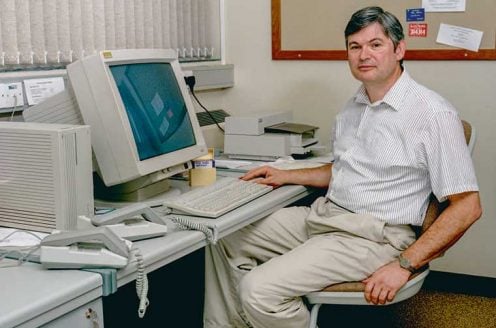
Figure 8. Alan Fersht in early 1990s in the Centre for Protein Engineering.
Credit: MRC Laboratory of Molecular Biology.
Credit: MRC Laboratory of Molecular Biology.
In 2013, the LMB moved from a cramped 1960s building on one side of the Cambridge Biomedical campus into a large and superb new building on the other side. The case for funding the new building had been fortified by the revenues generated for the MRC and HM Treasury by the antibody technologies and the expectation that further revenues might follow from such opportunistic translation of curiosity-driven research. However, throughout my time, the LMB itself had limited space, resources or appetite for translational work. To see my work applied I had to “privatise” the more translational aspects outside the LMB, whether through the CPE, CAT, Domantis or Bicycle Therapeutics. The move to the new building weakened the spell that had bound me to the LMB.
When in 2012 I was offered the Mastership of Trinity College, I accepted it – I was very grateful to the College (and its Fellows) for their catalytic role in my life. Brian Hartley had been my undergraduate Director of Studies at College, and had persuaded me, through his infectious enthusiasm, to build a research career in molecular biology. David Blow, also a Fellow of the College, had taken me as a summer student to build a display model of the enzyme trypsin, igniting my interest in the structure and mechanism of proteins. Another Trinity man, Michael Neuberger, had provided me with the expression vectors that got me started in the antibody world; Michael had also sent me one of his Trinity undergraduates, Ian Tomlinson (later Domantis) as a PhD student.
As a Fellow of the College, I already had some idea of the changes in store for me as Master. I was installed in the Master’s Lodge, a Tudor palace, and expected to “exercise a general superintendence over the affairs of the College.” My main role was to maintain the good order of the College by attending or presiding over its meetings and activities, making speeches and representing the College externally. However almost all powers were reserved to the College Council, which generally aimed to reach a wide consensus before agreeing any change, delegating matters of substance for deliberation by sub-committees, which might only meet once or twice a year. The pace of change was glacial, but the effect of small tweaks here and there seemed to work, and the College continued to perform well academically and in its investments.
I did nevertheless preside over some changes, including the development of better relations with the College’s alumni and the provision of more space and a higher profile for early stage companies at the College-owned Cambridge Science Park. I also continued with my involvement with Bicycle Therapeutics and some other biotechnology companies and started to advise venture funds in biotechnology investments. At the time of writing, as I come to the end of my tenure as Master, I expect that some combination of science, medicine and start-up companies will underpin my future activities.
Note 1. In our early publications, we referred to such antibodies as “reshaped” human antibodies: the field later adopted the alternative term of “humanised” mouse antibodies, and which I have used here.
Note 2. I would however like to acknowledge and thank the following who worked with me at the LMB and CPE, with apologies to those inadvertently omitted: David Barker, Hugues Bedouelle, Elise Bernard, Tim Bonnert, George Brownlee, Yvonne Bruggeman, Marianne Bruggeman, Jackie Bye, Paul Carter, David Chiswell, Cyrus Chothia, Daniel Christ, Peter Christensen, Tim Clackson, Graham Cook, Simon Corbett, Jonathan Cox, Stephanie de Bono, Ruud de Wildt, Paul Dear, John Doorbar, Alexander Duncan, M. James Embleton, Kristoffer Famm, Alan Fersht, Stanley Fields, Mariangela Figini, John Finch, Riccarda Finnern, Igor Fisch, Nicolas Fischer, Kevin FitzGerald, Jefferson Foote, Stefan Freund, Jean-Pol Frippiat, Michael Gait, Ermanno Gherardi, Steffen Goletz, Barbara Gorick, Guy Gorochov, Heather Griffin, Andrew Griffiths, Detlef Gussow, Oliver Hartley, Brian Hartley, Robert Hawkins, Christian Heinis, Regina Hodits, Philipp Holliger, Hennie Hoogenboom, Peter Hudson, Nevin Hughes-Jones, Olga Ignatovich, Leo James, Philip Jennings, Laurent Jespers, Jean-Luc Jestin, Kevin Johnson, Peter Jones, Abraham Karpas, Perry Kirkham, Gordon Koch, Roland Kontermann, Peter Kristensen, Arthur Lesk, Meirion Llewelyn, Benny Lo, Nigel Low, John Lund, Stefan Luzi, Stephen Mahler, Magnus Malmqvist, Roy Mariuzza, James Marks, Cara Marks, Pierre Martineau, John McCafferty, Andrew McLachlan, César Milstein, Dario Neri, Michael Neuberger, Ahuva Nissim, Rosaria Orlandi, Willem Ouwehand, Didrik Paus, Olga Perisic, Terence Prospero, Terence Rabbitts, Lutz Riechmann, Stephen Russell, Trevor Rutherford, Fiona Sait, Oliver Schon, Arne Skerra, Geoffrey Smith, Sirirurg Songsivilai, Dan Teufel, Ian Tomlinson, Hiroshi Ueda, Marina Vaysburd, Dmitry Veprintsev, Martine Verhoeyen, Herman Waldmann, Edward Walker, Gerald Walter, Peter Wang, E. Sally Ward, Peter Waterhouse, Mary Waye, Roger Williams.
This autobiography/biography was written at the time of the award and later published in the book series Les Prix Nobel/ Nobel Lectures/The Nobel Prizes. The information is sometimes updated with an addendum submitted by the Laureate.
Nobel Prizes and laureates
Six prizes were awarded for achievements that have conferred the greatest benefit to humankind. The 12 laureates' work and discoveries range from proteins' structures and machine learning to fighting for a world free of nuclear weapons.
See them all presented here.
